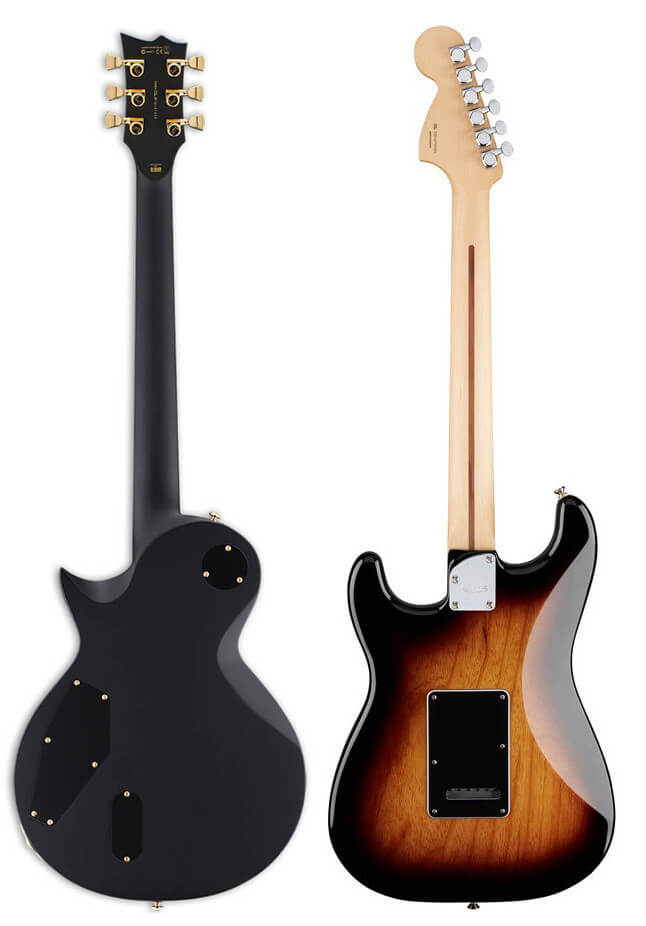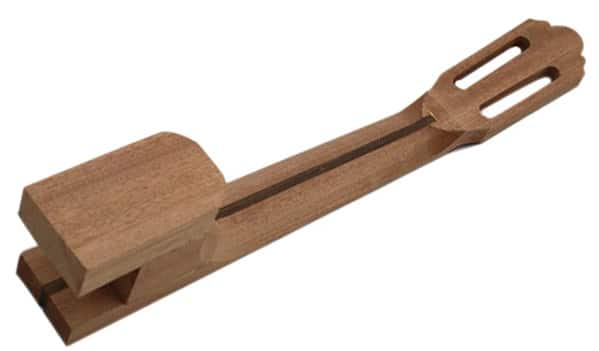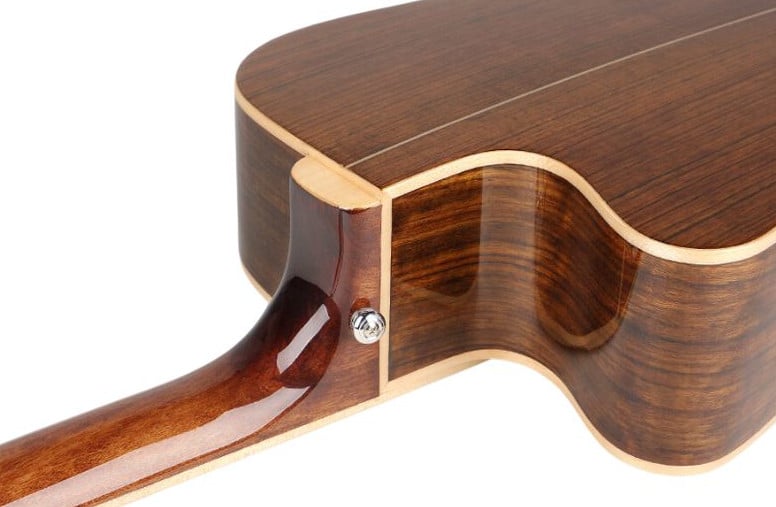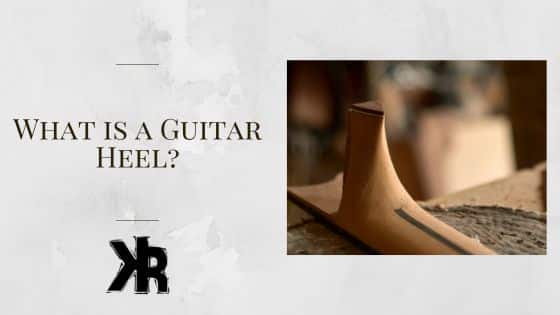Table of Contents
Within the intricate architecture of this beloved instrument, there lies a component often overlooked, yet undeniably crucial, the guitar heel.
This humble piece found at the junction of the neck and body, plays a pivotal role in the guitar’s construction, its importance echoing beyond its size.
The heel stands as a beacon of stability, a cornerstone that holds the instrument together. It’s a silent hero, often unnoticed, yet its absence would render the guitar a mere collection of strings and wood.
This Killer Rig article aims to shine a spotlight on this unsung hero. To get deep into its mysteries, and explore its role in the creation of the music that moves our souls.
What is the Heel on a Guitar?
Think about where the long, slender neck of a guitar meets its larger body. That’s the spot we call the heel of the guitar.
Why is it important? Well, it’s a kind of hero in disguise! It strengthens and balances the guitar where it needs it most, at the meeting point of the neck and body. It’s like the instrument’s own personal bodyguard, protecting its most delicate and fragile area.
Without the heel, that joint could easily break. So, it’s more than just a junction, it’s a vital support system.
The heel’s location, at the rear of the guitar, is strategic. It’s positioned where the neck and body converge, a point of high stress due to the tension of the strings.
This placement makes the heel a critical component in maintaining the structural integrity of the guitar, ensuring that every strum and note resonates with perfect harmony.
The heel may not command the spotlight like the strings or the body, but in its quiet way, it’s a key player in the composition that is a guitar.

Related: Thin or Thick Neck?
The Role of the Guitar Heel
The heel’s primary role is to serve as a bridge, a nexus that connects the neck and body of the guitar. This connection is more than just physical.
It’s a conduit for the transfer of vibrations that allows the resonance from the strings to flow into the body of the guitar. Creating the rich, full-bodied sound that we associate with this instrument.
But the heel’s role doesn’t stop at sound transmission. It’s also a support structure that bears the brunt of the string tension. Every time a guitarist strums the strings or presses down on the frets, the resulting tension is transferred to the heel.
This makes the heel critical in maintaining the guitar’s tuning stability, ensuring that each note rings true, no matter how aggressively the strings are played.
The heel also contributes to the overall balance and ergonomics of the guitar. The weight distribution of the instrument and how easily a guitarist can reach the upper frets can both be impacted by its size and form.
A well-designed heel can make the difference between a guitar that feels awkward and one that feels like an extension of the musician’s body.
Different Types of Guitar Heels
In the world of guitars, diversity is the name of the game. From the body’s shape to the type of strings, every element can be customized to create the perfect instrument.
The guitar heel is no exception. Here’s a look at the different types of guitar heels that grace the music world:

Bolted Heel
The bolted heel, a modern marvel in guitar construction, is often seen in electric models. This design involves the neck being attached to the body using bolts or screws. The bolted heel’s charm lies in its practicality.
It allows for easy repair and maintenance, and even the replacement or customization of the neck becomes a breeze. However, it’s not all roses. The bolted heel may not offer the same level of vibration transfer as its counterparts, potentially affecting the guitar’s tone.
Glued Heel
The glued heel, a classic, is a common sight in high-end acoustic guitars. This design involves the neck and body being seamlessly joined using high-quality woodworking glue.
The glued heel is a testament to craftsmanship, offering superior vibration transfer and a smooth transition from the neck to the body.
However, it comes with its own set of challenges. Repairs and adjustments can be complex due to the permanent nature of the joint.
Related: Bolt on or Set neck?
Spanish Heel
The Spanish heel is a hallmark of classical and flamenco guitars. This design involves the neck being inserted into a notch in the guitar body and secured using a combination of glue and internal wooden dowels. It’s stronger than any other design.
The Spanish heel is celebrated for its tonal benefits, owing to the increased size of the joint. It’s also well known for its aesthetic appeal, often adorned with intricate inlays or carvings. However, like the glued heel, repairs and adjustments can be complex.

Materials Used For the Guitar Heel
When it comes to guitar construction, the choice of materials is one of the most important factors.
Each material adds its own qualities that have an impact on the instrument’s sound and playability in addition to its appearance. Despite its small size, the guitar heel falls under this category.
Traditional Woods
Historically, the heel has been carved from the same wood as the rest of the guitar. Mahogany, with its rich, warm tones and excellent workability, has been a popular choice.
Maple, known for its bright tonality and striking grain patterns, is another favorite. Rosewood, prized for its deep, resonant sound and beautiful coloration, is also used, especially in high-end guitars.
Read our article on guitar neck wood here.
Modern Materials
As technology has advanced, so too have the materials used in guitar construction. Some manufacturers have begun to experiment with synthetic materials for the guitar heel.
Carbon fiber, known for its exceptional strength and light weight, is one such material. Plastic composites, which offer excellent durability and resistance to changes in temperature and humidity, are another.
Each material brings its own sound to the guitar. Traditional woods like mahogany and maple tend to produce warm, rich tones, while modern materials like carbon fiber can enhance the guitar’s sustain and projection.
The choice of material can also impact the guitar’s weight and balance, affecting its overall playability.

Common Issues and How to Fix Them
Just like any piece of finely crafted machinery, a guitar is not immune to wear and tear. Over time, the guitar heel, despite its robust construction, can encounter issues that may affect the instrument’s performance.
However, fear not, for many of these problems are fixable, often restoring the guitar to its former glory.
Cracks or Loose Joints
One of the most common issues with guitar heels is the development of cracks or loose joints.
Or maybe the joints decide to loosen up. This can happen with changes in humidity, an unfortunate bump or drop, or even just something that happens with time.
How to Fix
To repair minor cracks, first obtain quality woodworking glue. Apply the glue thoroughly to the cracked area, ensuring deep penetration. Then, use a clamp to press the two sides together and allow sufficient time for the glue to dry.
For major cracks or loose joints, a comprehensive repair might be necessary. This can include detaching and replacing the heel of the guitar.
This task demands advanced skills in guitar repair and should ideally be performed by a professional instrument repair technician.
Replacing a Guitar Heel
The guitar heel might need to be completely replaced in some circumstances. This might be the result of major damage, like a significant crack or break. Or it might be a matter of personal interest to change the guitar’s sound or playability.
How to Fix
Replacing a guitar heel is a complex process. It involves removing the old heel and fitting a new one to the guitar body.
The new heel must be carefully shaped and fitted to the body to ensure stability and proper tension. Given the complexity of this process, it’s recommended that heel replacements be carried out by a professional luthier.
Heel Size And Guitar Stability
The guitar heel plays a pivotal role in the stability of the instrument. Its size, often overlooked, can have a significant impact on the guitar’s balance, playability, and even its sound.
A larger heel, with its increased surface area, can provide a stronger joint between the neck and body. This can enhance the guitar’s stability, ensuring it can withstand the tension of the strings without bending or warping.
A larger heel can also improve the transfer of vibrations from the neck to the body, potentially enhancing the guitar’s tone.
However, a larger heel is not always better. A heel that is too large can make the guitar feel unbalanced, especially when playing in a standing position. And good luck reaching those high notes, they’re off-limits with a large heel.
However, a heel that is too small may not provide sufficient support for the neck, potentially compromising the guitar’s stability and tuning rigidity.
The guitar’s heel has got to be just right! Not too big to mess with your groove, not too tiny to risk a wobbly guitar.
The key lies in finding that perfect middle ground, the one that brings harmony between support and play. Most manufacturers design their guitars with the perfect heel, and so for most players, this isn’t something to worry about.
Conclusion
People don’t usually pay attention to the guitar heel. Yet, it’s no small player in the scheme of things. Can you imagine if the guitar had no heel? Prone to snap where the neck meets the body, struggling to stay in tune, and sounding off-beat.
With this in your mind, you’re sure to look at it differently from now on. Isn’t it fascinating how something so small can make such a huge difference?
It’s working behind the scenes, keeping everything together. There’s more to it than meets the eye. Now, you’re in the know about its role and importance.
FAQ
What is the Heel Length of a Guitar?
Depending on the type, a guitar’s heel length can change quite a bit. The part of the neck that reaches into the guitar body and offers support and stability is typically referred to as the heel length.
On certain electric guitars, this can be a few inches. But on classical or Spanish-style guitars, it’s much longer.
How do you measure guitar heels?
Typically, you would measure a guitar heel from the top of the body, where the neck starts, all the way to the heel’s bottom.
A ruler or a measuring tape can be used to take this measurement. The back of the neck should be measured since it will provide the most precise measurement.
Is a 2 inch heel too high for a guitar?
A 2-inch heel is not necessarily too high for a guitar. The ideal heel size can depend on a variety of factors, including the type of guitar, the materials used, and the player’s personal preferences.
A larger heel can offer additional support and stability, but it may also seem unbalanced or make it harder to reach the higher frets.
What is the best heel size for a guitar?
Many people who play the guitar go for a heel size hovering around 2 and 3/16 inches in width. This size is typically the sweet spot for a comfortable grip, giving the player stability for various music styles.
When it comes to designing a guitar, the heel is a big deal. If done right, it gives the neck of the guitar the support it needs to stay rigid.
A premium guitar heel won’t mess with how easy the instrument is to play or how good it sounds. It’s all about striking the right balance.
Does Guitar Center fix cracked guitars?
Yes, Guitar Center does offer repair services, including fixing cracked heels. Their technicians are experienced in a wide range of guitar repairs and can often fix issues like cracks or loose joints.
However, it’s always a good idea to contact your local Guitar Center or check their website for specific details about their repair services. Just keep in mind that there are many great luthiers around that are more than capable of performing this work.

